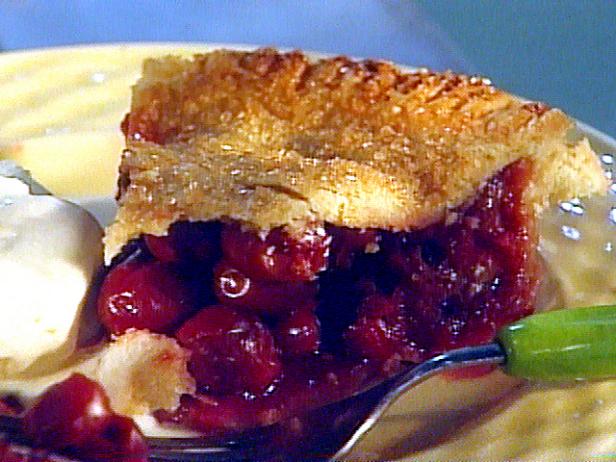Sour Morello cherries are the ultimate, but sourcing them is as difficult as panning for gold these days. Just by the best cherries you can (Bing or Lambert are easier to find), and a good catapult of a pitter to pit them with, a messily satisfying and repetitive job. The crunch of a demerara sugar top and a solid scoop of whipped cream makes this the pie for me. The cornstarch is needed to thicken the weeping cherry juices and stop them from flooding the crust.
| Level: | Intermediate |
| Total: | 2 hr 35 min |
| Prep: | 35 min |
| Inactive: | 1 hr |
| Cook: | 1 hr |
| Yield: | 6 servings |
Ingredients
- 1 pound and 10 ounces sour cherries, pre-pitted weight; or 6 cups frozen or jarred
- 1 to 2 tablespoons kirsch
- 1/2 cup raw sugar
- 4 tablespoons cornstarch
- Shortcrust pastry dough made with 2 1/2 cups all-purpose flour and 2/3 cup unsalted butter, recipe follows
- Beaten egg, for glaze
- 1 tablespoon demerara sugar
Instructions
- Pit the cherries, then macerate them in a large bowl with the kirsch and sugar for 1 hour or so. If using jarred cherries, strain and reserve 1/4 cup juice to mix with the cornstarch. Pour off the juice that has collected into a smaller bowl and stir in the sifted cornstarch to thicken it. Return the thickened juice to the cherries.
- Preheat the oven to 400 degrees F.
- Divide the dough into roughly 2/3 and 1/3. Roll out the larger piece for the bottom of the pie and drop it into a greased pie pan. Pour in the cherry mixture. Roll out the second piece of dough and place it over the cherries, crimping the edges together well with the tines of a fork. Brush the top with beaten egg, then sprinkle the demerara. Make a couple of slashes in the crust for the steam to escape and bake the pie for about 40 minutes or until the top has browned. Serve warm or at room temperature with clotted or whipped cream, or a la mode with homemade vanilla ice cream.
- Use approximately twice the weight of all purpose flour (preferably organic) to unsalted butter. Some recipes call for half butter, half lard.
- Sift the flour and a pinch of sea salt into a food processor, then cut the cold butter into small pieces on top of it. I process it for 20 to 30 seconds, then add ice-cold water through the top, a tablespoon at a time, 2 to 2 1/2 minutes should be enough for about 10 ounces of dough, with the machine running. If the paste is still in crumbly little bits after 1 or 2 minutes, add a tablespoon more water, but remember, the more water you use, the more the crust will shrink if you bake it blind. One solution is to use a bit of cream or egg yolk instead of water. The moment the dough has cohered into a single ball, stop, remove it, wrap it in plastic wrap and put it in the fridge for at least 30 minutes.
- If you’re making pastry dough by hand, sift the flour into a large bowl with the salt, add the chopped butter, and work as briskly as you can to rub the fat into the flour. Use the tip of your fingers only, rather like running grains of hot sand through your fingers. Add the water bit by bit as above; wrap and chill the dough.
- If you’re making a double crust pie, divide the dough into roughly 2/3 and 1/3. Then scatter a bit of flour on your work surface, roll your rolling pin in it, dust the palms of your hands, and start rolling. Always roll away from yourself, tuning the dough as you go, and keep the rolling pin and work surface floured to prevent sticking.
- Preheat the oven to 375 to 400 degrees F.
- Line your greased pie pan with dough. Never stretch it; it will stretch back. Try to leave at least 30 minutes for the unbaked dough to commune with the inside of your fridge. Or put it in the night before you need it.
- Tear off a piece of waxed paper a little larger than the pie pan and place it over the dough. Cover the paper with a layer of dried beans; the idea is to prevent the pastry from rising up in the oven. When the dough is nearly cooked (the timing depends on the rest of the recipe), remove the paper and beans and prick the bottom of the pie shell to let out trapped air that would otherwise bubble up. Return the tart to the oven for 5 to 10 minutes to dry the bottom. Brushing the partly baked pie shell with a light coating of beaten egg or egg white ensure a crisp finished tart.
